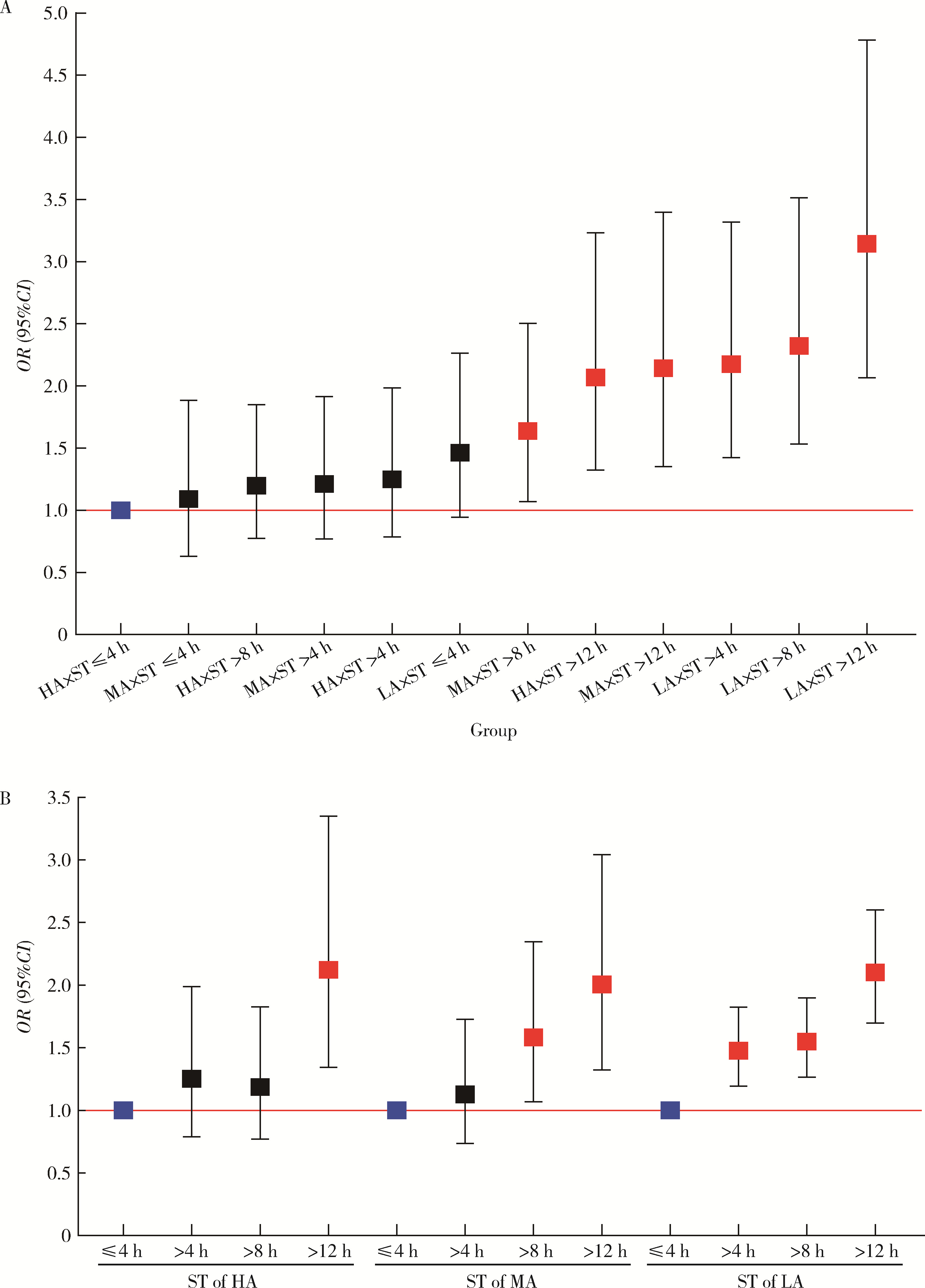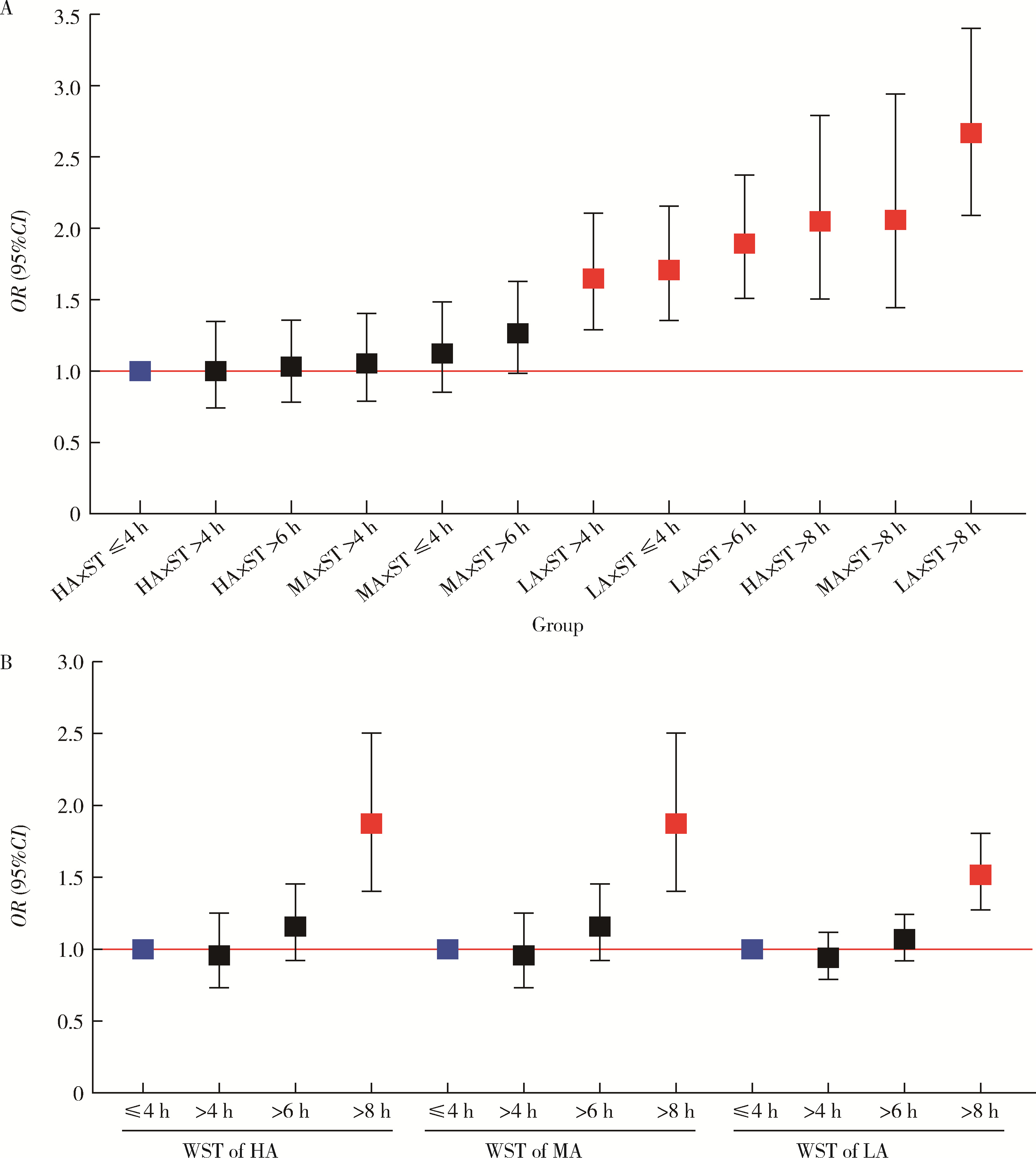Journal of Peking University (Health Sciences) ›› 2022, Vol. 54 ›› Issue (3): 490-497. doi: 10.19723/j.issn.1671-167X.2022.03.014
Previous Articles Next Articles
Joint association of sedentary behavior and physical activity on anxiety tendency among occupational population in China
Yi-hua LIU,Qing-ping YUN,Lan-chao ZHANG,Xiao-yue ZHANG,Yu-ting LIN,Fang-jing LIU,Zhi-jie ZHENG,Chun CHANG*( )
)
- Department of Social Medicine and Health Education, Peking University School of Public Health, Beijing 100191, China
CLC Number:
- R131
| 1 |
Charlson FJ , Baxter AJ , Cheng HG , et al. The burden of mental, neurological, and substance use disorders in China and India: A systematic analysis of community representative epidemiological studies[J]. Lancet, 2016, 388 (10042): 376- 389.
doi: 10.1016/S0140-6736(16)30590-6 |
| 2 | 健康中国行动推进委员会. 健康中国行动(2019—2030年)[EB/OL]. (2019-07-15)[2020-11-20]. http://www.gov.cn/xinwen/2019-07/15/content_5409694.htm. |
| 3 |
Dewa C , Lesage A , Goering P , et al. Nature and prevalence of mental illness in the workplace[J]. Healthc Pap, 2004, 5 (2): 12- 25.
doi: 10.12927/hcpap..16820 |
| 4 |
Schuch FB , Vancampfort D , Firth J , et al. Physical activity and incident depression: A meta-analysis of prospective cohort studies[J]. Am J Psychiatry, 2018, 175 (7): 631- 648.
doi: 10.1176/appi.ajp.2018.17111194 |
| 5 |
Kandola A , Ashdown-franks G , Stubbs B , et al. The association between cardiorespiratory fitness and the incidence of common mental health disorders: A systematic review and meta-analysis[J]. J Affect Disord, 2019, 257, 748- 757.
doi: 10.1016/j.jad.2019.07.088 |
| 6 |
Clemes SA , Oconnell SE , Edwardson CL . Office workers' objectively measured sedentary behavior and physical activity during and outside working hours[J]. J Occup Environ Med, 2014, 56 (3): 298- 303.
doi: 10.1097/JOM.0000000000000101 |
| 7 |
Kroenke K , Spitzer RL , Williams JB , et al. Anxiety disorders in primary care: Prevalence, impairment, comorbidity, and detection[J]. Ann Intern Med, 2007, 146 (5): 317- 325.
doi: 10.7326/0003-4819-146-5-200703060-00004 |
| 8 |
Sedentary Behaviour Research Network . Standardized use of the terms "sedentary" and "sedentary behaviours"[J]. Appl Physiol Nutr Metab, 2012, 37 (3): 540- 542.
doi: 10.1139/h2012-024 |
| 9 | Bartholomew LK , Markham CM , Ruiter RAC , et al. Planning health promotion programs: An intervention mapping approach[M]. San Francisco: Jossey-Bass, 2016. |
| 10 | 吕燕宇, 姜红如, 张兵, 等. 中国四省18~60岁职业人群抑郁情绪现状及其影响因素[J]. 环境与职业医学, 2020, 37 (5): 427- 432. |
| 11 |
Richardson S , Mcneill A , Brose LS . Smoking and quitting beha-viours by mental health conditions in Great Britain (1993-2014)[J]. Addict Behav, 2019, 90, 14- 19.
doi: 10.1016/j.addbeh.2018.10.011 |
| 12 |
姜学文, 鞠巍, 常春. 职业人群焦虑和抑郁状况与工作环境的通径分析[J]. 中国心理卫生杂志, 2019, 33 (5): 375- 380.
doi: 10.3969/j.issn.1000-6729.2019.05.012 |
| 13 |
Patterson R , Mcnamara E , Tainio M , et al. Sedentary behaviour and risk of all-cause, cardiovascular and cancer mortality, and incident type 2 diabetes: A systematic review and dose response meta-analysis[J]. Eur J Epidemiol, 2018, 33 (9): 811- 829.
doi: 10.1007/s10654-018-0380-1 |
| 14 |
Park JH , Moon JH , Kim HJ , et al. Sedentary lifestyle: Overview of updated evidence of potential health risks[J]. Korean J Fam Med, 2020, 41 (6): 365- 373.
doi: 10.4082/kjfm.20.0165 |
| 15 | 艾磊, 罗维, 鹿琦, 等. 不同体型成年人在平躺、久坐、睡眠和运动状态下代谢当量与能耗的比较研究[J]. 成都体育学院学报, 2021, 47 (3): 106- 112. |
| 16 |
Zhai L , Zhang Y , Zhang D . Sedentary behaviour and the risk of depression: A meta-analysis[J]. Br J Sports Med, 2015, 49 (11): 705- 709.
doi: 10.1136/bjsports-2014-093613 |
| 17 |
Kraut R , Patterson M , Lundmark V , et al. Internet paradox: A social technology that reduces social involvement and psychological well-being?[J]. Am Psychol, 1998, 53 (9): 1017- 1031.
doi: 10.1037/0003-066X.53.9.1017 |
| 18 |
Spittaels H , Cauwenberghe EV , Verbestel V , et al. Objectively measured sedentary time and physical activity time across the lifespan: A cross-sectional study in four age groups[J]. Int J Behav Nutr Phys Act, 2012, 9, 149.
doi: 10.1186/1479-5868-9-149 |
| 19 |
Colley RC , Garriguet D , Janssen I , et al. The association between accelerometer-measured patterns of sedentary time and health risk in children and youth: Results from the Canadian Health Measures Survey[J]. BMC Public Health, 2013, 13, 200.
doi: 10.1186/1471-2458-13-200 |
| 20 |
Stamatakis E , Gale J , Bauman A , et al. Sitting time, physical activity, and risk of mortality in adults[J]. J Am Coll Cardiol, 2019, 73 (16): 2062- 2072.
doi: 10.1016/j.jacc.2019.02.031 |
| [1] | Shan CAI,Yihang ZHANG,Ziyue CHEN,Yunfe LIU,Jiajia DANG,Di SHI,Jiaxin LI,Tianyu HUANG,Jun MA,Yi SONG. Status and pathways of factors influencing physical activity time among elementary and junior high school students in Beijing [J]. Journal of Peking University (Health Sciences), 2024, 56(3): 403-410. |
| [2] | Jin-hui LAI,Qi WANG,Jia-xiang JI,Ming-rui WANG,Xin-wei TANG,Ke-xin XU,Tao XU,Hao HU. Effects of delayed ureteral stents removal during the COVID-19 pandemic on the quality of life and psychological status of postoperative patients with urinary calculi [J]. Journal of Peking University (Health Sciences), 2023, 55(5): 857-864. |
| [3] | Wen YUAN,Yi ZHANG,Li CHEN,Jia-nuo JIANG,Man-man CHEN,Jie-yu LIU,Tao MA,Qi MA,Meng-jie CUI,Tong-jun GUO,Xin-xin WANG,Yan-hui DONG,Jun MA. Association of body fat distribution with depression and social anxiety in children and adolescents: A cross-sectional study based on dual-energy X-ray detection [J]. Journal of Peking University (Health Sciences), 2023, 55(3): 429-435. |
| [4] | Yi-fan WANG,Zhen FAN,Yao-bin CHENG,Yue-bo JIN,Yang HUO,Jing HE. Investigation of sleep disturbance and related factors in patients with primary Sjögren’s syndrome [J]. Journal of Peking University (Health Sciences), 2020, 52(6): 1063-1068. |
| [5] | Yan GENG,Zhi-bo SONG,Xiao-hui ZHANG,Xue-rong DENG,Yu WANG,Zhuo-li ZHANG. Depression and anxiety in patients with psoriatic arthritis: Prevalence and associated factors [J]. Journal of Peking University (Health Sciences), 2020, 52(6): 1048-1055. |
| [6] | Xiao-na NA,Zhu ZHU,Yang-yang CHEN,Dong-ping WANG,Hao-jie WANG,Yang SONG,Xiao-chuan MA,Pei-yu WANG,Ai-ping LIU. Associations of distribution of time spent in physical activity and sedentary behavior with obesity [J]. Journal of Peking University (Health Sciences), 2020, 52(3): 486-491. |
| [7] | Yi SONG,Dong-mei LUO,Pei-jin HU,Xiao-jin YAN,Jing-shu ZHANG,Yuan-ting LEI,Bing ZHANG,Jun MA. Trends of prevalence of excellent health status and physical fitness among Chinese Han students aged 13 to 18 years from 1985 to 2014 [J]. Journal of Peking University (Health Sciences), 2020, 52(2): 317-322. |
| [8] | Duan YI,Wei ZHU,Xiu-li MENG,Xiao-guang LIU,Shui-qing LI,Bin ZHU,Dong-lin JIA. Analysis of anxiety, depression and related factors in patients with chronic lumbocrural pain before minimally invasive surgery [J]. Journal of Peking University (Health Sciences), 2020, 52(2): 285-289. |
| [9] | WU Shi-yan1, ZHANG Xu-xi1, SUN Kai-ge1, HU Kang, LIU Si-jia, SUN Xin-ying. Application of multi-group structural equation model in comparative study of HBM related to recreational physical activity among population with high risk of chronic diseases and healthy people [J]. Journal of Peking University(Health Sciences), 2018, 50(4): 711-716. |
| [10] | SONG Yi,LEI Yuan-ting, HU Pei-jin, ZHANG Bing, MA Jun. Situation analysis of physical fitness among Chinese Han students in 2014 [J]. Journal of Peking University(Health Sciences), 2018, 50(3): 436-442. |
| [11] | WANG Tian-jiao, LIU Yu, GUAN Ming. Intravenous sedation with midazolam and propofol target controlled infusion on patients’ perioperative anxiety under the mandibular third molar extraction [J]. Journal of Peking University(Health Sciences), 2017, 49(6): 1044-1049. |
| [12] | ZHOU Jing, ZHOU Qian, WANG Dong-ping, ZHAGN Ting, WANG Hao-jie, SONG Yang, HE Hai-zhen, WANG Meng, WANG Pei-yu, LIU Ai-ping. Associations of sedentary behavior and physical activity with dyslipidemia [J]. Journal of Peking University(Health Sciences), 2017, 49(3): 418-423. |
| [13] | LEI Jie,LIU Mu-qing,FU Kai-yuan. Disturbedsleep, anxiety and stress are possible risk indicators for temporomandibular disorders with myofascialpain [J]. Journal of Peking University(Health Sciences), 2016, 48(4): 692-696. |
| [14] | WU Shi-yan, ZHANG Xu-xi, YANG Shuai-shuai, SUN Kai-ge, JIA Wei-lan, SHAO Chun-xin, WU Qin, XUAN Xiao-wei, LIU Yong-chang, LIU Si-jia, SUN Xin-ying. Physical activity level and its influence factors among residents in one suburb district of Beijing [J]. Journal of Peking University(Health Sciences), 2016, 48(3): 483-490. |
| [15] | CHENG Lan, LI Qin, SONG Yi, MA Jun, WANG Hai-Jun. Association of physical activities, sedentary behaviors with overweight/obesity in 9-11 year-old Chinese primary school students [J]. Journal of Peking University(Health Sciences), 2016, 48(3): 436-441. |
|
||



